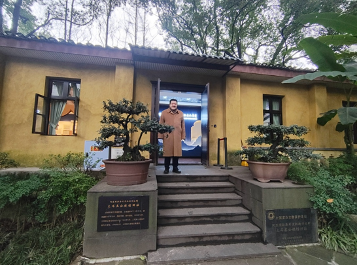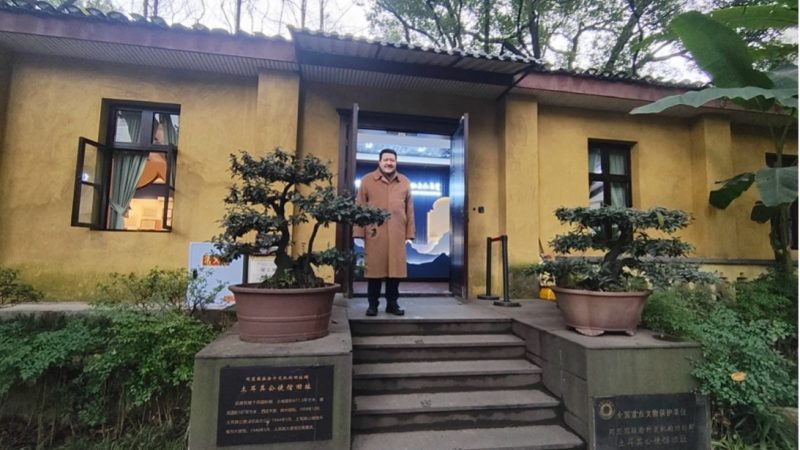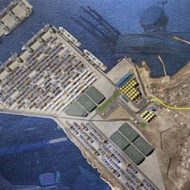It has long been said, “If only these walls had a language, they could tell us what is going on”. In reality, walls and buildings have a language. Buildings are witnesses of history. Since time immemorial, I have been interested in the traces of buildings in humanity’s struggle for progress.
Last week, during my visit to Chongqing one of the four provincial-level cities of China, I had the chance to visit a building with low walls and a light roof that tells a great deal despite its small size. I examined Türkiye’s “veteran” Embassy building, which operated under intense bombardment during the Japanese occupation.
In 2016, the Chongqing People’s Government restored these building and other former embassy chanceries in the neighborhood and opened them to the public.
Now a museum, this modest one-store building tells us a lot.

Duty under heavy Japanese bombardment
According to “Chongqing Fang Kong Zhi”, a book recording the air defenses in Chongqing, the capital city during the resistance to Japanese occupation, the Japanese occupiers carried out a strategic bombing offensive from 18 February 1938 to 19 December 1944, lasting six years and dubbed the “Mass Explosion in Chongqing”.
The Turkish Embassy building continued to serve for 5 years of the 6-year bombardment and shouldered the resistance of the Chinese people. Our Embassy, which was opened during the heavy bombardment, had a share in the heroic city of Chongqing to continue its struggle without giving up. In relations with China, the epic resistance of the Chinese people against the Japanese occupation
For some reason, Türkiye’s this important support is not emphasized by herself. Unfortunately, Turkish diplomacy, which has been under NATO’s guidance since 1947 and still has not fully recovered from this dependence, is trying to keep this commendable action under the radar.
The crimes against humanity committed by Japanese imperialism in World War II and the legendary resistance of the Chinese people are little known to the Turkish public. Hollywood cinema, which exploited the Second World War to the point of madness, has always ignored the heroic resistance of the Chinese people for fear that it would be credited to Mao Zedong.
Solidarity of revolutionary China and revolutionary Türkiye
Diplomatic relations between revolutionary Türkiye, led by Atatürk, and the revolutionary Republic of China, led by Sun Yat Sen, were established in 1925. However, the relationship did not reach the stage of opening mutual embassies until four years later. (1)
In 1929, Türkiye appointed Mr. Hulusi Fuad Tugay, Ambassador of Türkiye to Japan, as Chargé d’affaires to China. Hulusi Fuad Tugay travelled to Shanghai on 1 April 1929 and to Nanjing, the capital city at that time, on 9 April 1929 and was received by the Minister of Foreign Affairs. The embassy building in Nanjing could not be opened due to lack of space, and activities were carried out from Shanghai. In 1931, the opening of the embassy was postponed due to economic reasons.
In the conditions leading up to the Second World War, Türkiye and China sign a Friendship Treaty in 1934. In 1935, China appoints He Yao Zu, an influential general, as its ambassador to Türkiye.
Türkiye opens its embassy in China after a gap of 8 years, in 1939. Emin Ali Sipahi, one of the legal advisors of the Ministry of Foreign Affairs, arrives in Chongqing on the morning of 21 December 1939 as “Middle Envoy”. Sipahi is received by Chiang Kai Shek on 27 December and begins his duty as the first Turkish ambassador to China. Mr. Emin Ali goes to open an embassy in Shanghai in 1940, returns to Türkiye a year later, but our embassy in Chongqing remains open. Under wartime conditions, Y. Sedes and A. Mennan Tebelen were appointed as Chargé d’Affaires on 20 March 1942.
In 1943, bilateral relations were upgraded to ambassadorial level and Hulusi Fuat Tugay was appointed as our first Ambassador to Chongqing and presented his letter of credence on 13 June 1944.
Every June 5, sirens sound for the martyrs of Chongqing
Since 1938, the air defense warning siren in Chongqing has sounded every 5 June to commemorate the victims of the “Jiaochangkou Great Tunnel Massacre” in 1941 and the victims of the Japanese bombardment.
In the first half of 1938, the Japanese army bombed Chongqing intermittently. After occupying Wuhan in October, Japan decided to comprehensively bomb Chongqing, the war capital of the People’s Republic of China, in early December in order to break the resolve and will of the Chinese government and people to resist Japan.
Chongqing also served as the capital of the Japanese-occupied Republic of Korea at the time.
The period from May 1939 to August 1941 was the most intense period of Japanese bombardment and the time when Chongqing residents suffered the most. On 3 and 4 May 1939, Japanese aircraft from Wuhan to Chongqing indiscriminately dropped incendiary bombs on the Yuzhong District and other densely populated areas, killing 3,991 people, injuring 2,323, and leaving nearly 200,000 homeless in the fires that lasted for two days and two nights. (2)
At that time, Chongqing became one of the four most important capitals in the fight against fascism, along with Moscow, Washington and London. The people of Chongqing resisted the bombardments by taking shelter in the tunnels they dug in the city built among the mountains.
On 5 June 1941, Japanese planes carried out another bombardment over Chongqing for more than five hours. Thousands of people flocked to the shelter at Jiaochangkou. More than 2,000 people suffocate to death here. Countless others are injured. The “Jiaochangkou Great Tunnel Massacre” became the massacre with the largest indirect death toll in the Second World War.
Foreign embassies and consulates, together with the Chongqing army and people, resist the Japanese bombardment. They are witnesses to the “Mass Bombardment of Chongqing” and an important part of the history of Chongqing as the temporary wartime capital.
Recognize the right of the Chinese people to defeat fascism
The Japanese invasion began on 18 September 1931. Japanese troops destroyed a section of the railway in the city of Shenyang in northeast China. And they blamed China for this act. Then they used it as an excuse to invade and occupy China for the next 14 years.
Six years later, gunfire on Lugou Bridge or Marco Polo Bridge in Beijing signaled the full-scale invasion of Japan. This made China the first country to be occupied by a fascist state in the Second World War… And China was the first to resist.
In World War 2, the Chinese people made the greatest contribution to the defeat of Fascism through their legendary resistance to Japan.
On 15 August 1945, Japan announced its unconditional surrender. This move also marked the end of the Second World War.
When China began its war of resistance, it was facing two-thirds of Japan’s land forces and most of its naval and air forces. More than 35 million Chinese soldiers and civilians made the ultimate sacrifice. They did a great service to their country and to humanity.
Thanks to the People’s government of Chongqing!
Türkiye’s “veteran” Embassy building stands in E’ling Park as a monument to the Chinese people’s struggle against fascism. Its neighbors are the Danish and Austrian Embassies.
As Türkiye, we owe a debt of gratitude to the Chongqing People’s Government. They remind us of an action we can be proud of.
But we also have our duties:
The historical records exhibited in the Embassy Building are naturally based only on Chinese sources. We should enrich this memorial museum with documents from Türkiye’s Foreign Affairs and Presidential Archives.
Also, we should find China’s first diplomatic building in Ankara in 1935 and convert it into a museum.
Footnotes:
1. The most comprehensive research on China-Türkiye relations between 1923 and 1949, based on the archives of both countries, was conducted by Necati Demircan, a PhD student at Shanghai University. See: “Interaction between the two republics: Relations between the Republic of Türkiye and the Republic of China (1923-1949). Belt and Road Initiative Journal (BRIQ) Volume 3 Issue 1, pp.26-39.









Leave a Reply